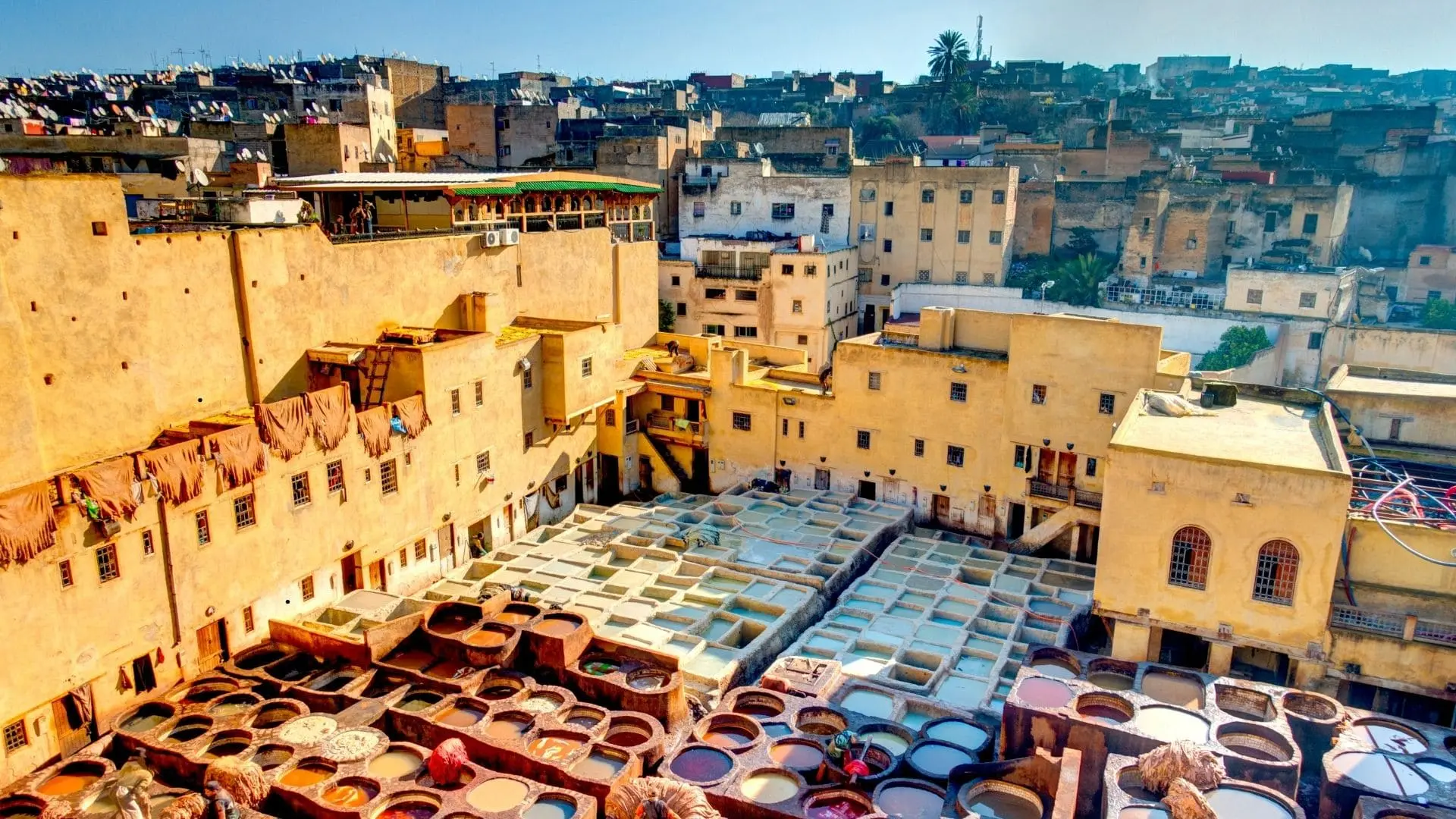
Step into a labyrinth of history, where the scent of spices lingers in the air, the call to prayer echoes through narrow alleys, and vibrant souks buzz with centuries-old craftsmanship. The Medina of Fez is not just a place—it’s an experience, a living museum where time seems to stand still. As the world’s largest car-free urban zone and a UNESCO World Heritage Site, this ancient walled city is Morocco’s spiritual and cultural heartbeat.
Whether you’re a history buff, a culture seeker, or an adventurer at heart, the Medina of Fez promises an unforgettable journey. Let’s uncover its secrets, from hidden madrasas to the legendary tanneries, and discover why this medieval marvel deserves a top spot on your travel bucket list.
This post contains affiliate links. If you book through these links, I may earn a small commission at no extra cost to you.
Morocco’s Spiritual and Cultural Capital
Fez is more than just a city, it’s the soul of Morocco. Founded in the 9th century, it served as the country’s capital for centuries and remains its intellectual and spiritual center. The Medina of Fez (Fes el-Bali) is the oldest part, a maze of over 9,000 alleys where donkeys still outnumber cars.
Unlike Marrakech’s more touristy medina, Fez retains an authentic, untouched charm. Here, traditions run deep—from handwoven textiles to age-old Quranic schools—making it a must-visit for travelers craving a deeper connection with Moroccan heritage.
The Ancient Medina of Fez: A UNESCO World Heritage Site
Declared a UNESCO World Heritage Site in 1981, the Medina of Fez is a masterpiece of medieval Islamic urban planning. Its winding streets, historic gates (like the iconic Bab Bou Jeloud), and preserved architecture tell stories of dynasties, scholars, and artisans who shaped Morocco’s identity.
Key highlights of its UNESCO status include:
- Al-Qarawiyyin University (the world’s oldest continuously operating university)
- Bou Inania Madrasa (a stunning example of Marinid architecture)
- Traditional funduqs (caravanserais) where merchants once traded goods
What to See in Fez Medina: Souks, Crafts, and Hidden Corners
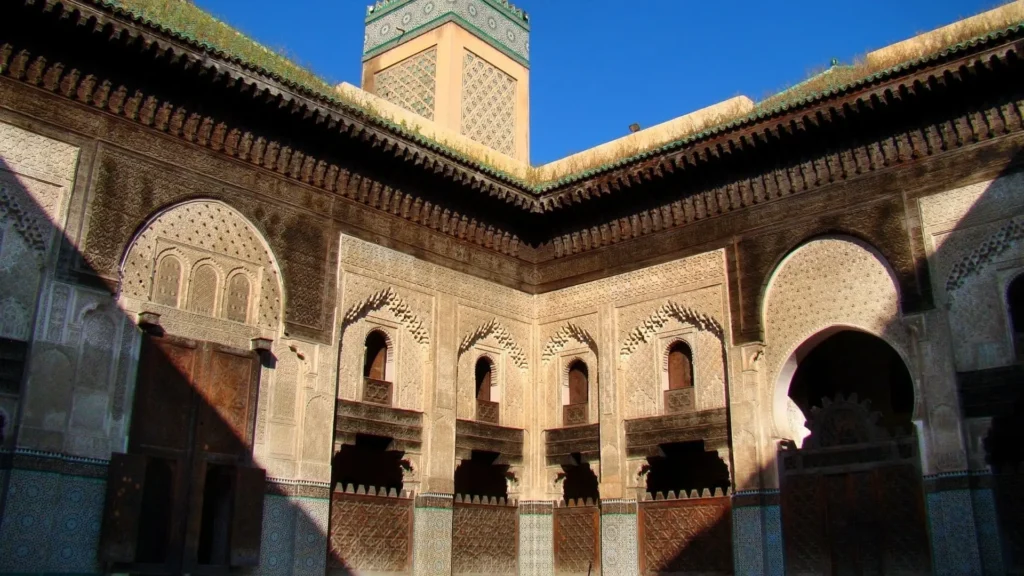
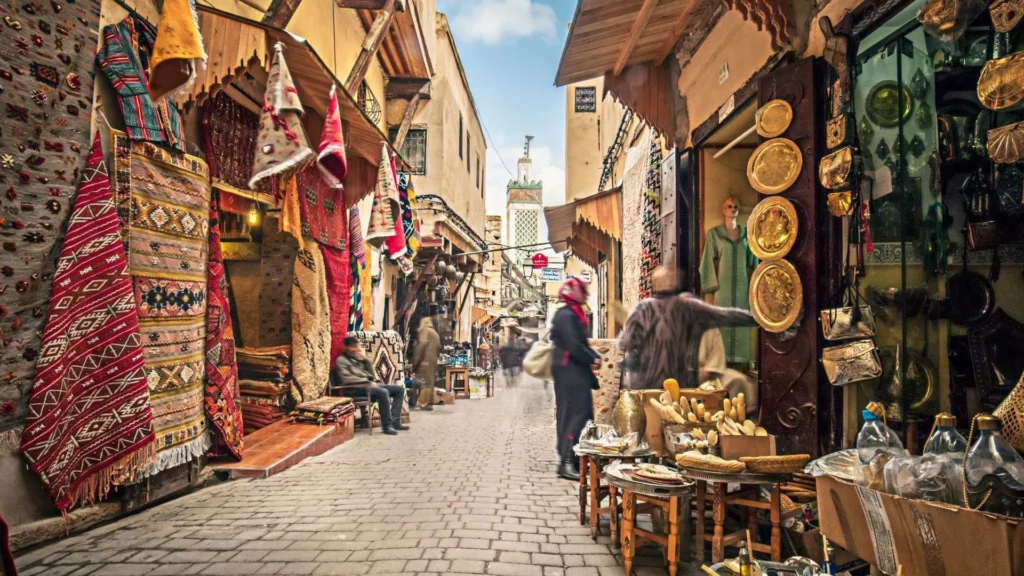
1. The Vibrant Souks of Fez
From the Chouara Tanneries to the Souk el-Attarine (perfume market), Fez’s markets are a sensory overload. Don’t miss:
- Souk el-Henna (for natural cosmetics)
- Place Seffarine (coppersmiths hammering away)
2. Hidden Gems Off the Beaten Path
While most tourists stick to the main alleys, true treasures lie in quieter corners:
- Dar Batha Museum (showcasing Moroccan arts)
- Al-Attarine Madrasa (a lesser-known architectural gem)
Spiritual Sites and Historical Landmarks You Can’t Miss
1. Al-Qarawiyyin Mosque & University
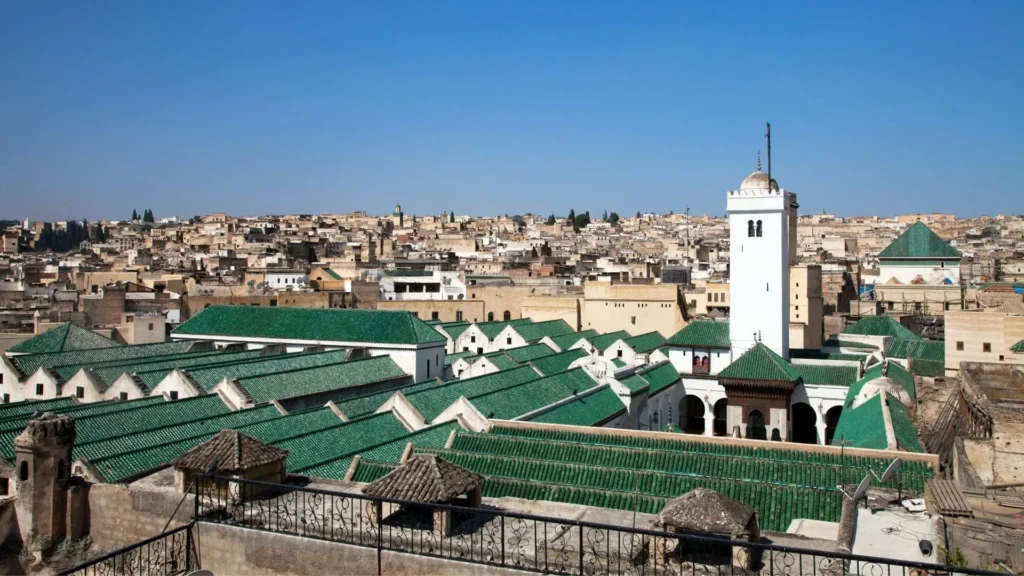
Founded in 859 AD, Al-Qarawiyyin is the world’s oldest university. Amazingly, a Tunisian woman named Fatima al-Fihri created it. First, it was just a mosque. Later, it became a famous center of learning.
Although non-Muslims can’t enter the mosque, visitors can see its beautiful gates. Nearby, the ancient library holds priceless books. In fact, some texts are over 1,000 years old!
This place isn’t just old – it’s still important today. Students still study here. Plus, it shows Morocco’s long love of education. For history fans, it’s a must-see stop in Fez.
2. Bou Inania Madrasa
Step through the towering brass doors of the Bou Inania Madrasa, and you’ll find yourself transported to the 14th century—the golden age of Fez’s architectural splendor. Built between 1351 and 1357 by Sultan Abu Inan Faris, this isn’t just a theological school; it’s one of the few religious monuments in Fez open to non-Muslims. Offering a rare glimpse into the sacred artistry of the Merinid dynasty.
Every inch of this spiritual-academic complex is a testament to Moorish mastery:
Innovative Engineering: Note the astronomical clock above the entrance (now inactive)—a marvel of medieval science that once called worshippers to prayer.
Hypnotic Zellij Tilework: Geometric mosaics in cobalt blue, emerald green, and sunbeam yellow form mathematical patterns so precise they’re said to reflect the universe’s divine order.
Celestial Cedar Carvings: The prayer hall’s honey-hued ceiling blooms with carved vines, Quranic calligraphy, and star-shaped muqarnas that seem to dissolve into the heavens.
3. Zaouia of Moulay Idriss II
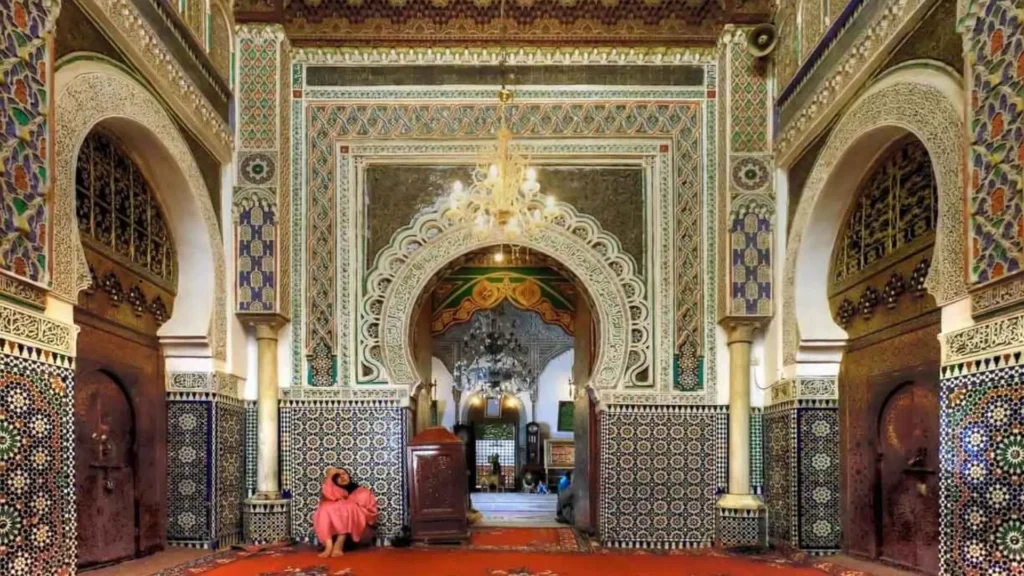
Step into the hallowed grounds of the Zaouia of Moulay Idriss II, where the very soul of Fez seems to pulse through the intricately carved stucco and gilded arches. This breathtaking mausoleum houses the tomb of Moulay Idriss II, the 9th-century ruler who transformed Fez from a modest settlement into Morocco’s spiritual and intellectual capital.
More than just a historical monument, this sacred site remains one of Morocco’s most important pilgrimage destinations. Devotees believe that seven visits to the zaouia equal one pilgrimage to Mecca, making it a place of profound spiritual significance. The air hums with whispered prayers, the scent of burning incense, and the quiet shuffling of bare feet on centuries-old tiles.
While non-Muslims cannot enter the inner sanctum, visitors can:
- Marvel at the exquisite Moorish architecture from the entrance courtyard
- Observe the ceremonial rituals during the annual Moussem (festival) of Moulay Idriss
- Feel the palpable energy of devotion that has drawn worshippers here for over 1,200 years
The zaouia’s location in the heart of the medina means you’ll likely stumble upon it while exploring – a golden-domed beacon guiding you through Fez’s labyrinthine alleys. Its spiritual gravity serves as a powerful reminder of how deeply history, faith, and daily life intertwine in this ancient city.
Traditional Life and Daily Scenes in the Medina
The Medina of Fez isn’t a relic—it’s a living, breathing community. Wander the alleys to witness:
- Bakers pulling fresh bread from communal ovens
- Craftsmen hand-shaping pottery in the Ain Nokbi district
- Storytellers captivating crowds in Place Bou Jeloud
The Famous Tanneries of Fez
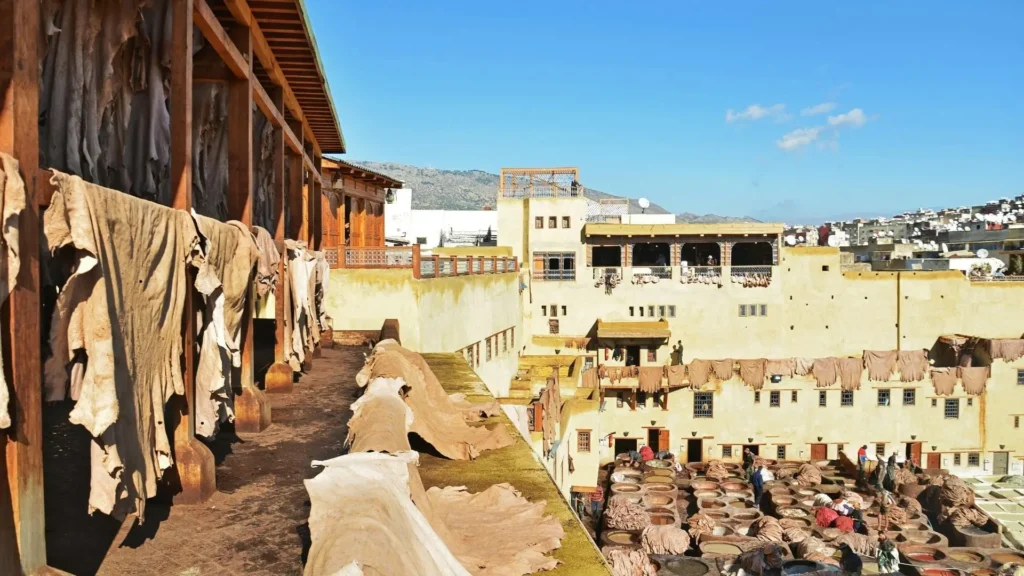
No visit to the Medina of Fez is complete without seeing the Chouara Tanneries, where leather has been dyed the same way since medieval times. Climb a terrace (tip: grab some mint to mask the smell!) and watch workers stomp vats of natural dyes—indigo, saffron, and poppy—creating vivid leather goods sold in nearby shops.
While Fez captivates with its ancient medina and timeless charm, Morocco’s modern capital, Rabat, offers a different but equally fascinating experience. From seaside kasbahs to French-colonial boulevards, Rabat blends history with a laid-back coastal vibe—without the crowds. Ready to discover another side of Morocco? Dive into our guide: Rabat: Discover Morocco’s Underrated Capital.
Where to Stay, Eat, and Explore More
Best Places to Stay in Fez: Riads & Boutique Hotels
1. Riads in the Heart of the Medina
For an immersive experience, stay in a traditional riad (a Moroccan guesthouse with an interior courtyard).
- Riad Fes – A palatial luxury retreat once home to 19th-century nobility, where hand-carved cedar ceilings, intricate zellij tilework, and a tranquil courtyard pool create a regal escape. The rooftop terrace offers panoramic views over the medina’s minaret-studded skyline, perfect for sunset mint tea.
- Dar Seffarine – Tucked just steps from the Chouara tanneries, this budget-friendly gem feels like stepping into a Fez family home. Its ivy-draped courtyard, antique brass lanterns, and home-cooked breakfasts (served on traditional copper trays) embody old-world Moroccan charm.
- Riad Laaroussa – A 17th-century mansion turned boutique hotel, featuring soaring arched doorways, a heated plunge pool, and a spa with hammam rituals. Its lush orange-tree courtyard and gourmet Moroccan restaurant make it a romantic hideaway.
- Dar Bensouda – A design lover’s dream blending contemporary elegance with heritage details—think embroidered silk cushions, a marble fountain courtyard, and private terraces overlooking the medina. The in-house cooking classes with local chefs are a highlight.
2. Modern Comforts in Ville Nouvelle
Prefer contemporary amenities? The New Town offers stylish stays just outside the medina.
- Hotel Sahrai – Chic design, an infinity pool, and panoramic medina vistas.
Where to Eat in Fez: From Street Food to Fine Dining
1. Café Clock – Fez’s Cultural Hub
Famous for its signature camel burger—a must-try Moroccan twist on a classic—as well as its lively evenings of traditional Gnawa music, storytelling, and cultural events, Café Clock has become an iconic gathering spot beloved by backpackers, foodies, and Fez locals looking for great flavors and vibrant atmosphere.
2. Restaurant Dar Hatim – Authentic Moroccan Flavors
Nestled in the labyrinthine alleys of Fez’s ancient medina, Restaurant Dar Hatim is a hidden gem where time seems to slow down. Family-run for generations, this intimate eatery specializes in painstakingly prepared Moroccan classics—think aromatic lamb tagines simmered for hours in clay pots, flaky pastilla dusted with cinnamon, and melt-in-your-mouth msemen (Moroccan pancakes) drizzled with local honey. The warm, lantern-lit ambiance and grandmotherly hospitality make every meal here feel like a cherished family gathering.
Beyond the Medina
- Day trip to Meknes & Volubilis (Roman ruins)
- Blue Gate (Bab Bou Jeloud) at sunset for the perfect photo
If the earthy tones of Fez’s medina left you enchanted, wait until you wander the vibrant blue alleyways of Chefchaouen. Nestled in the Rif Mountains, this photogenic town offers serene streets, artisan shops, and breathtaking mountain views. Continue your Moroccan adventure with our guide to the Best Things To Do in Chefchaouen.
Why the Medina of Fez Should Be Your Next Adventure
The Medina of Fez is more than a destination—it’s a journey through time. Whether you’re bargaining in the souks, marveling at ancient madrasas, or simply getting lost in its enchanting alleys, Fez offers an unmatched glimpse into Morocco’s soul.
Ready to explore? Pack your sense of adventure (and comfy shoes—those cobblestones are no joke!) and dive into the magic of Fez.
Medina of Fez FAQs
Absolutely! Fez is Morocco’s cultural and spiritual heart, home to the world’s oldest university (Al-Qarawiyyin), vibrant souks, and the iconic Chouara Tanneries. Its UNESCO-listed medina offers an authentic, less touristy experience compared to Marrakech.
The Medina of Fez (Fes el-Bali) is famous for:
Being the world’s largest car-free urban area
The 9th-century Al-Qarawiyyin Mosque and University
Traditional leather tanneries (like Chouara)
Its maze of 9,000 alleys filled with artisan workshops
Plan 2–3 days to explore Fez properly:
Day 1: The medina’s highlights (tanneries, madrasas, souks)
Day 2: Hidden gems + food tours
Day 3: Day trips to Meknes or Volubilis
Dress modestly to respect local culture:
Women: Loose clothing, scarves (for mosques), comfortable shoes for cobblestones
Men: Avoid shorts; lightweight pants/jeans are ideal
All: Pack layers—Fez can be hot by day and cool at night
It depends!
Fez is for culture lovers: more authentic, fewer crowds, deeper history.
Marrakech is for vibrancy: luxury riads, nightlife, and desert tours.
Tip: Visit both if you can! They’re just a 6-hour train ride apart.





Pingback: Top 15 Moroccan Street Foods & Where to Find Them